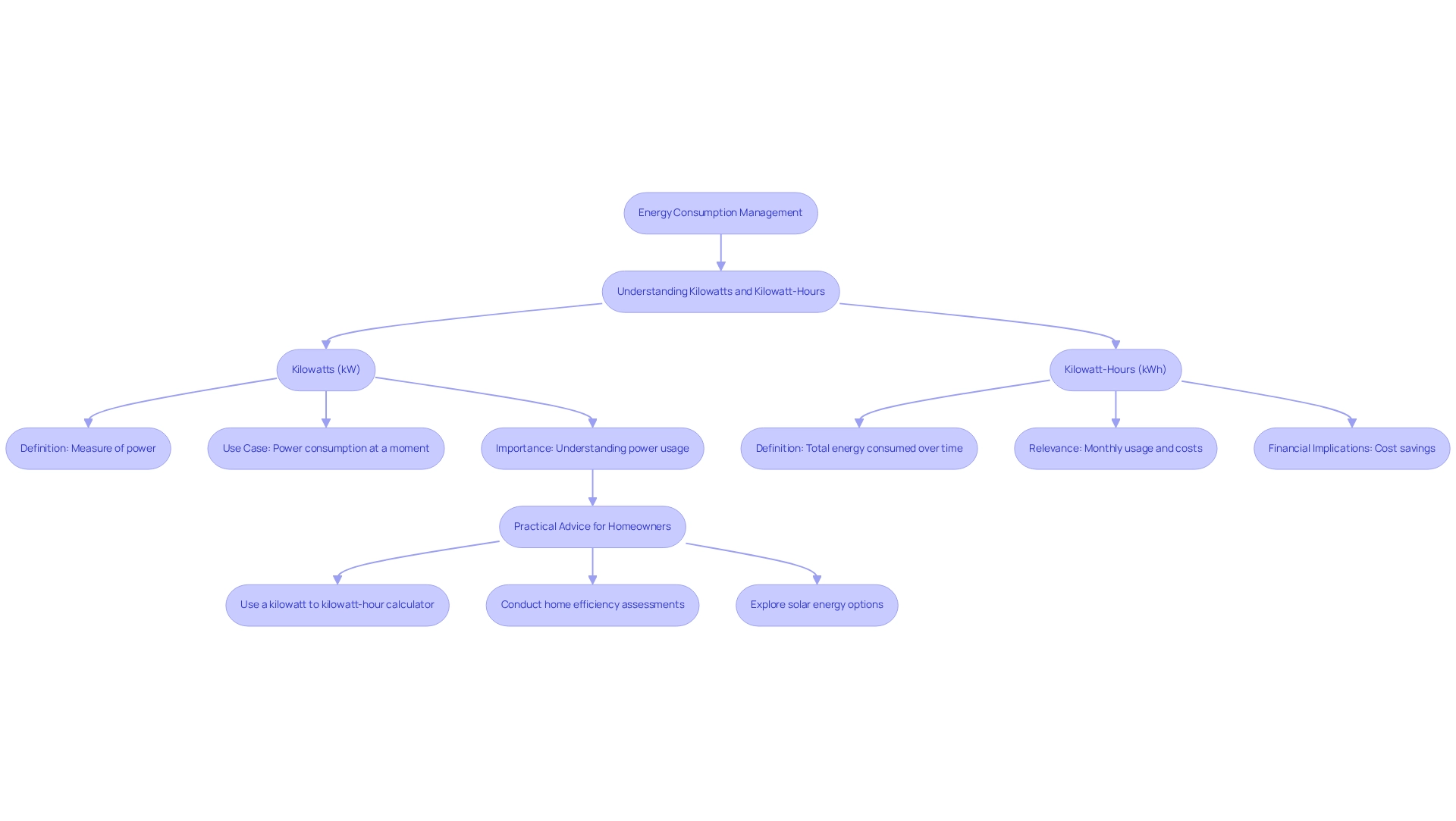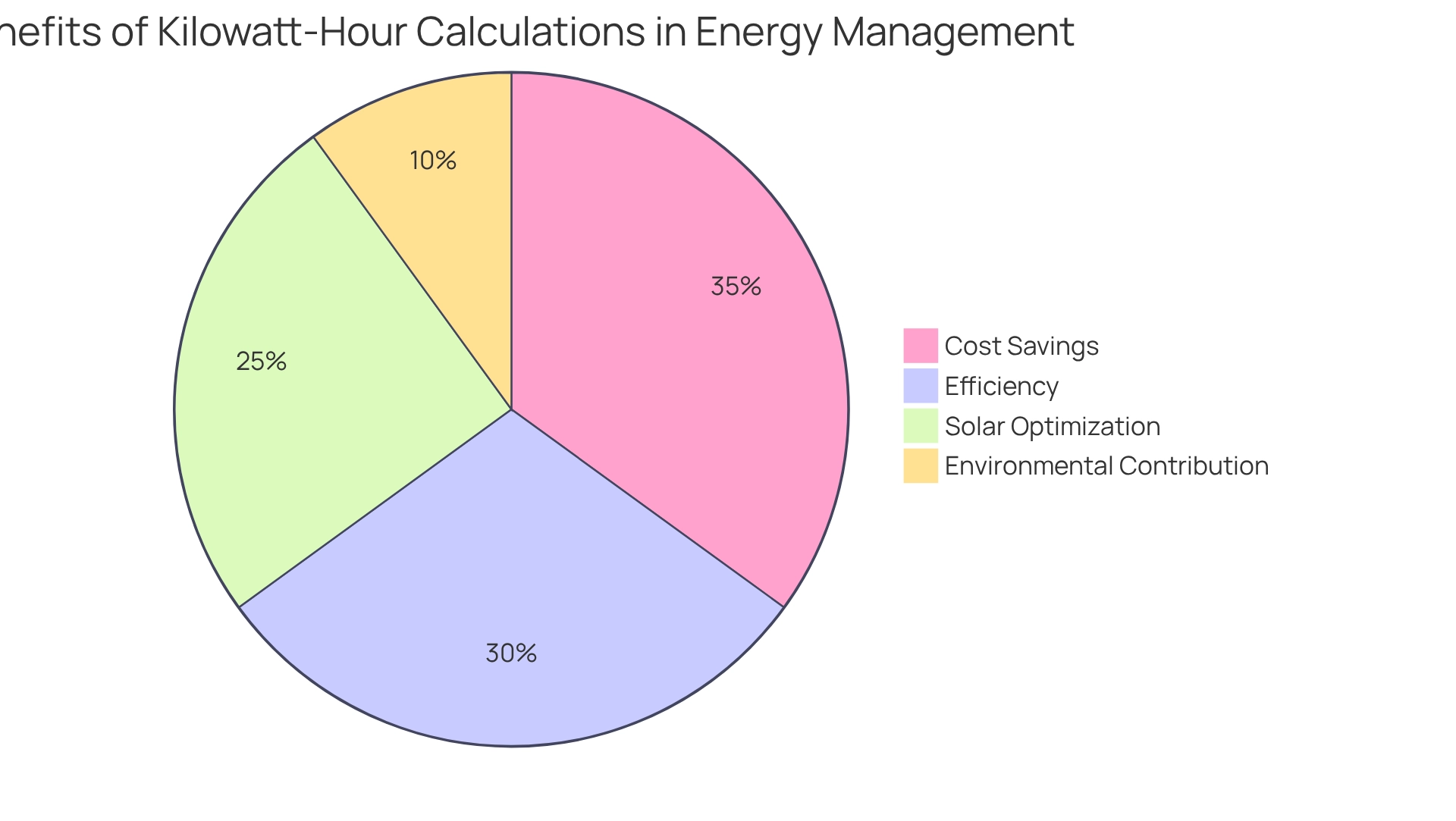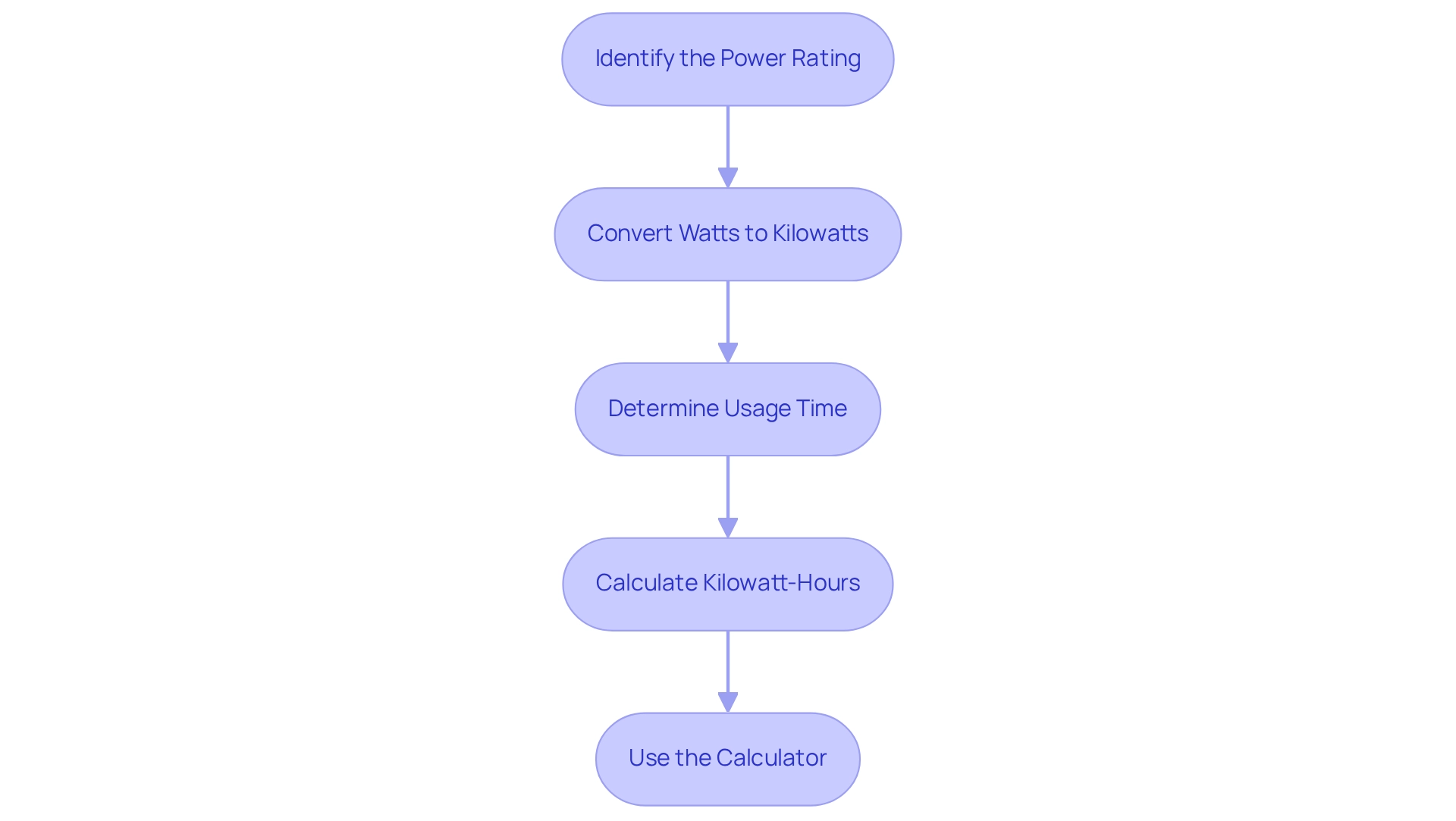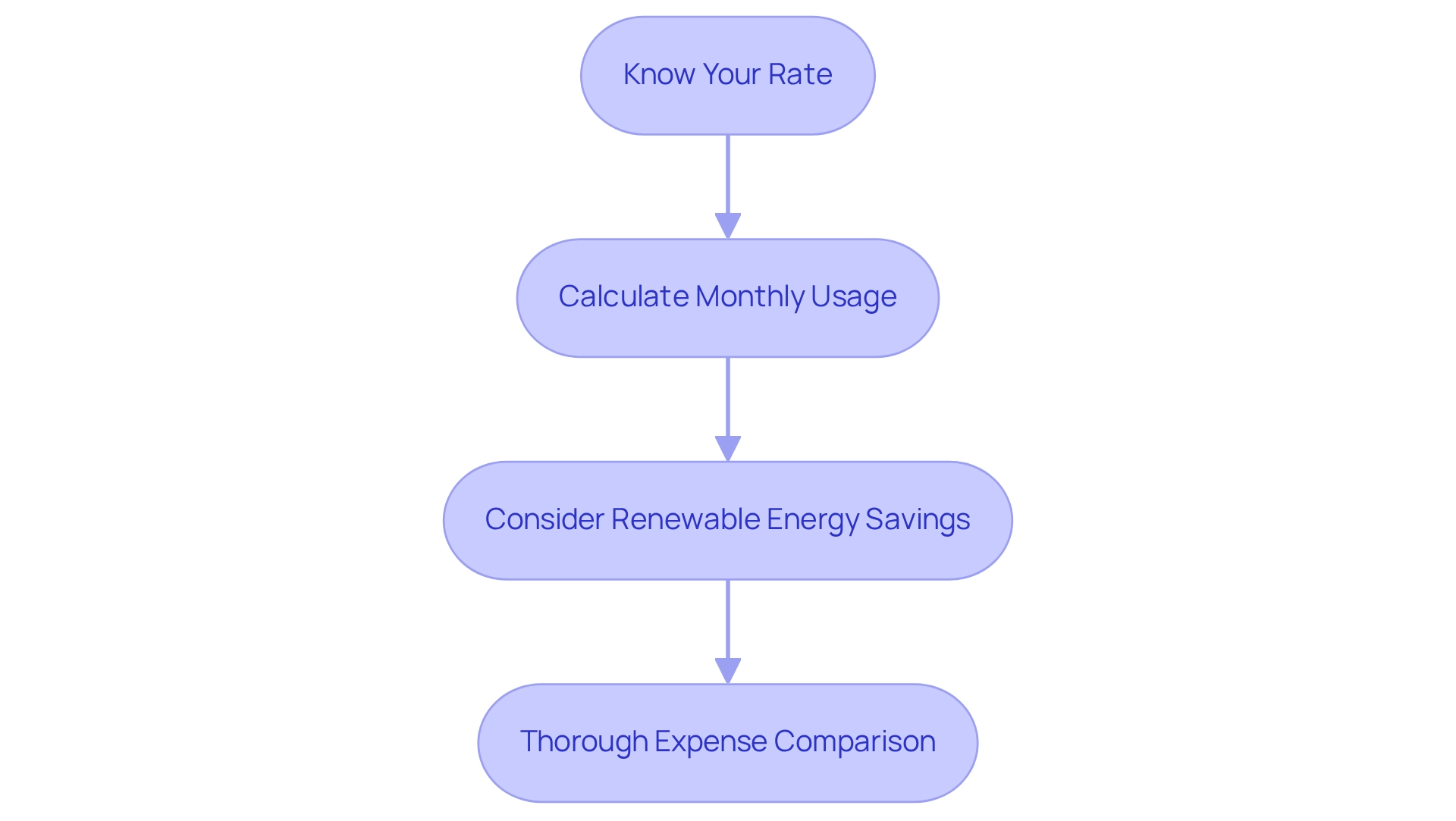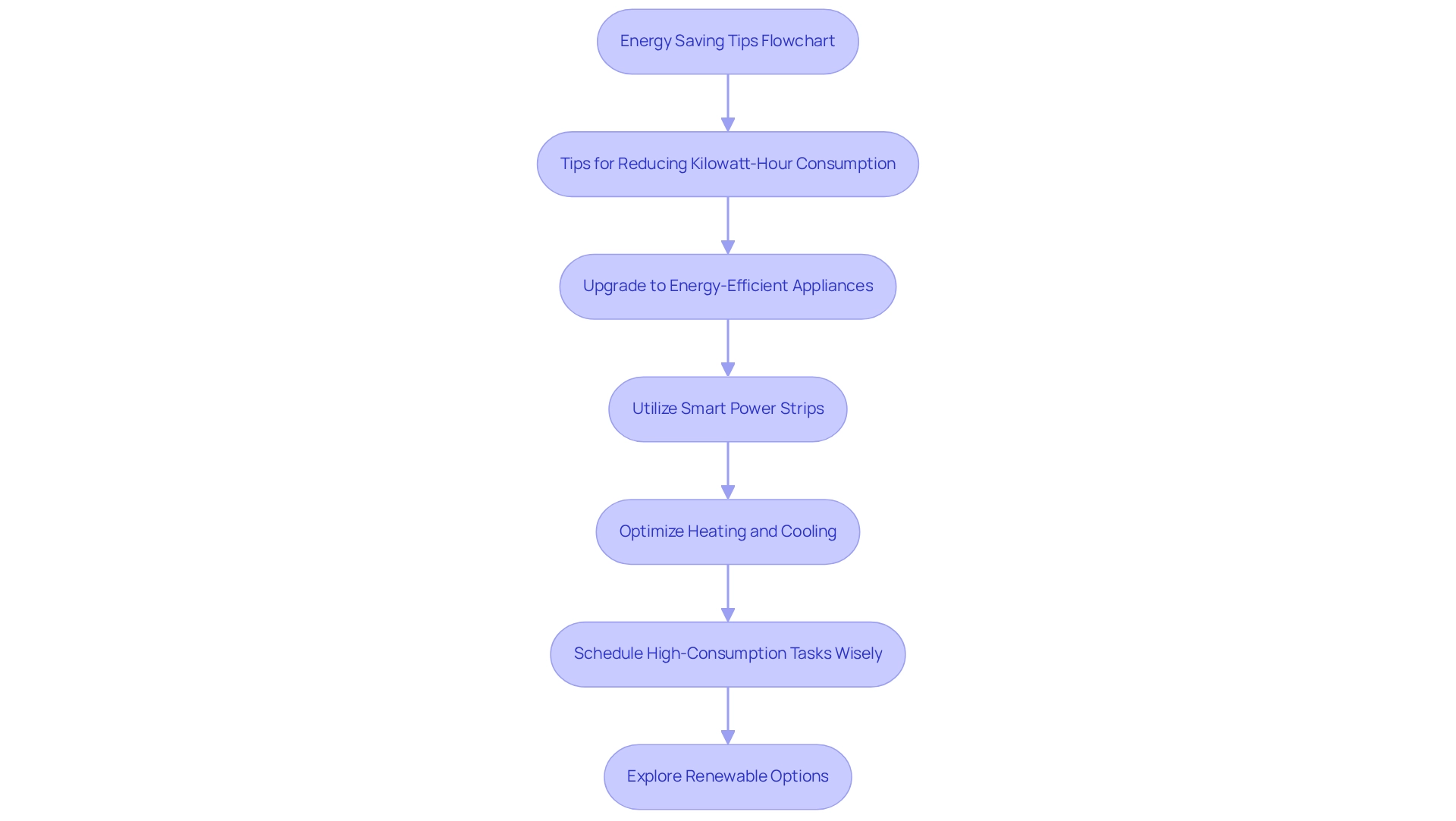Overview
This article addresses the concerns many homeowners have about managing energy consumption and reducing costs. Understanding the difference between kilowatts, which represent the rate of power consumption, and kilowatt-hours, the total energy used over time, is crucial. By effectively using a kilowatt to kilowatt-hour calculator, you can uncover significant savings on your electricity bills. Not only does this knowledge empower you, but it also promotes sustainable energy practices that benefit both your home and the environment.
We understand that energy bills can be a source of stress, and the desire for energy independence is common. By exploring the benefits of solar energy, you can take steps toward a more sustainable lifestyle. Imagine the peace of mind that comes from knowing you are doing your part to reduce consumption and save money.
Together, we can navigate these challenges. By utilizing tools like the kilowatt to kilowatt-hour calculator, you can make informed decisions that lead to both financial savings and a positive impact on the planet. Let’s work towards a future where energy independence is within your reach, and you feel supported every step of the way.
Introduction
In a world where energy costs are on the rise and sustainability is becoming increasingly vital, we understand that homeowners may feel overwhelmed by their energy bills. It’s common to seek clarity in understanding the nuances of kilowatts and kilowatt-hours, as these two measurements, often confused, play a crucial role in managing energy consumption effectively.
As California faces escalating electricity prices, monitoring and reducing kilowatt-hour usage can lead to significant savings and a more sustainable lifestyle. This article delves into the importance of these calculations, providing practical insights on how homeowners can optimize their energy use, embrace solar solutions, and ultimately contribute to a greener future while keeping their energy bills in check.
Together, we can explore the benefits of energy independence and find supportive ways to navigate this journey.
Understanding Kilowatts and Kilowatt-Hours
Kilowatts (kW) serve as a measure of power, illustrating the rate at which electricity is consumed by an appliance at any given moment. For example, a device rated at 1 kW uses 1,000 watts of power. In contrast, kilowatt-hours (kWh) measure the total amount consumed over time, with one kilowatt-hour indicating the use of 1 kW of power for one hour.
Understanding this distinction is crucial for homeowners who are concerned about their power usage, especially when exploring solar power options provided by Powercore Electric. We recognize that the typical California household uses around 550 kWh monthly in 2025, a figure that reflects the ongoing challenges with rising electricity expenses. With electricity costs projected to increase by 5-7% each year over the next decade due to infrastructure improvements, wildfire prevention strategies, and investments in sustainable energy, it becomes increasingly important to learn how to manage consumption effectively. This financial pressure underscores the importance of proactive resource management.
Homeowners can benefit from using a kilowatt to kilowatt-hour calculator to monitor and adjust their usage, leading to significant savings. For instance, if a household reduces its power usage by just 100 kWh each month, it could save approximately $120 annually, based on the current average rate of $0.20 per kWh in California. This proactive approach not only helps in managing expenses but also promotes independence from traditional power sources and supports sustainability.
Real-life examples show how residents are successfully managing their power consumption through diligent tracking of kilowatt-hours. By conducting professional home efficiency assessments, they can identify areas for improvement, leading to enhanced performance and reduced overall power usage. These audits provide valuable insights that help residents pinpoint specific appliances or habits that may be driving up utility costs.
By grasping the differences between kilowatts and kilowatt-hours, along with utilizing a kilowatt to kilowatt-hour calculator, residents can make informed decisions about their energy consumption, particularly as they consider integrating renewable energy systems. The choice between active and passive heating systems further enriches this understanding, as active systems can effectively regulate and distribute warmth, while passive methods rely on building design to optimize resource use. On overcast days, homeowners should contemplate solar panels specifically designed to perform well in low-light conditions, such as monocrystalline panels, known for their efficiency and performance even in less-than-ideal sunlight.
Moreover, legislative efforts aimed at aligning infrastructure investments with consumer protections against rising electricity costs further highlight the importance of understanding these calculations in today’s energy landscape. With Powercore Electric’s expertise, residents can transition to sustainable practices while safeguarding their homes from power interruptions, ultimately benefiting from savings, reduced ecological impact, and long-term value.
The Importance of Kilowatt-Hour Calculations in Energy Management
Calculating kilowatt-hours (kWh) using a kilowatt to kilowatt hour calculator is essential for managing your resources effectively and reducing costs. We understand that many homeowners are concerned about their energy bills. By utilizing a kilowatt to kilowatt hour calculator, you can gain insight into the power usage of various appliances over time. This knowledge empowers you to identify high-consumption devices and make informed adjustments to your usage. For instance, if your refrigerator consumes 1 kWh per day, this information allows you to budget accurately for your monthly electricity expenses.
Furthermore, for those harnessing photovoltaic systems, such as those offered by Powercore Electric, using a kilowatt to kilowatt hour calculator is crucial for optimizing savings by aligning consumption with production.
Benefits of Kilowatt-Hour Calculations:
- Cost Savings: Identifying opportunities to reduce usage can lead to significant reductions in monthly bills. Property owners who consistently track their kilowatt-hour consumption frequently report an average decrease in utility expenses of up to 20%.
- Efficiency: These calculations promote the use of efficient appliances and practices, contributing to a more sustainable household. By understanding your resource footprint, you can make wiser decisions that resonate with your eco-conscious values, especially when considering solar panel installations or battery backups from Powercore Electric.
- Solar Optimization: Accurate kWh calculations are vital for determining the appropriate size of solar systems and battery storage solutions provided by Powercore Electric. This ensures that you can maximize your investment in sustainable power, leading to greater autonomy and reliability.
In densely populated areas like San Francisco and Los Angeles, where a significant portion of California’s residents reside, efficient power management becomes increasingly important. Integrating tools and techniques for assessing power usage can further empower you. For example, the Environmental Protection Agency (EPA) recommends using analytical tools like AVERT and COBRA to evaluate the health and economic benefits of clean power initiatives.
By utilizing such resources, homeowners can not only reduce expenses but also contribute to broader environmental goals.
As Hannah Bastawrose, a mechanical engineering graduate, emphasizes, understanding efficiency is vital for lowering costs and enhancing sustainability. Ultimately, mastering and using a kilowatt to kilowatt hour calculator is a powerful way for residents to improve their power management practices, reduce expenses, and embrace sustainable living. Powercore Electric’s dedicated team ensures high-quality installations and maintenance of photovoltaic systems, battery backups, and EV charging stations, further supporting you on your journey toward effective resource management.
Testimonials from satisfied clients highlight the substantial savings and improved efficiency achieved through Powercore Electric’s services, reinforcing the value of investing in solar solutions.
How to Use a Kilowatt to Kilowatt-Hour Calculator: A Step-by-Step Process
Managing your energy consumption can feel overwhelming, especially when it comes to those rising electricity bills. However, using a kilowatt to kilowatt hour calculator is a straightforward process that empowers homeowners to take control of their usage effectively. Here’s how you can get started:
- Identify the Power Rating: Begin by checking the appliance’s wattage, typically found on a label or in the user manual. For example, a microwave may have a power rating of 800 watts.
- Convert Watts to Kilowatts: To convert the wattage to kilowatts, simply divide the wattage by 1,000. For the microwave, this calculation would be 800 watts ÷ 1,000 = 0.8 kW.
- Determine Usage Time: Estimate how many hours per day the appliance will be in use. If the microwave is used for 2 hours daily, note this duration.
- Calculate Kilowatt-Hours: Multiply the kilowatts by the number of hours utilized to determine total power consumption in kilowatt-hours. For the microwave, the calculation would be 0.8 kW × 2 hours = 1.6 kWh. Additionally, consider that a hairdryer uses approximately 1.5 kWh per hour, which can serve as a practical illustration for understanding power consumption.
- Use the Calculator: Finally, input the kilowatts and hours into the calculator to verify your results and gain insights into your power consumption.
This approach not only helps homeowners grasp their power usage but also supports informed choices regarding efficiency. As Virve Rouhiainen, a Senior Statistician, observes, ‘You can find the latest numbers, tables and figures of the statistics on the statistics page,’ emphasizing the importance of being informed about energy-related statistics. Recent data indicates that many homeowners are utilizing kilowatt to kilowatt hour calculators to track their consumption, highlighting a growing awareness of resource usage.
Furthermore, to assess monthly electricity expenses for a light bulb, calculate daily usage in kWh and multiply by the average electricity price and the number of days in a month. By embracing this approach, homeowners can efficiently manage their electricity expenses and contribute to a more sustainable energy future. Findings from the case study titled “Impact of Technology on the Sector” reveal that technological advancements have notably transformed the industry, leading to enhanced efficiency and innovative solutions for generation and consumption, thereby facilitating consumers’ adoption of sustainable practices.
Together, we can work towards a more sustainable energy future, ensuring that you feel empowered and informed every step of the way.
Common Scenarios for Calculating Kilowatt-Hours in Home Energy Use
Property owners often face the challenge of managing energy costs, and understanding kilowatt-hours can be a crucial step in this journey:
- Appliance Usage: Have you ever considered how much energy your washing machine consumes per cycle? By grasping this information, you can strategically plan laundry during off-peak hours, potentially lowering your electricity expenses. With the typical American household spending over $1,500 each year on electricity, optimizing appliance usage can lead to significant savings. Powercore Electric offers efficient solutions, including photovoltaic panels and battery backups, to help you make the most of your energy usage.
- Heating and Cooling: We understand that keeping your home comfortable while managing costs is essential. By calculating the power consumption of your HVAC systems, you can adjust settings to reduce energy use without sacrificing comfort, especially during peak demand periods. Powercore Electric provides power storage options that can assist in managing these expenses efficiently, ensuring you can rely on your systems when you need them most.
- Solar Power Generation: If you have photovoltaic panels installed, assessing the power generated in relation to your usage is vital. This comparison not only aids in effective energy management but also helps you maximize the benefits of renewable energy. With Powercore Electric’s expertise in solar installations, you can gain insights into both the economic and environmental advantages of utilizing clean energy.
- Backup Generators: Understanding the kilowatt-hours consumed during power outages is crucial for selecting the right backup generator. This knowledge ensures that you are prepared for emergencies without overspending on unnecessary capacity. Powercore Electric is here to help you choose a generator that meets your specific needs, ensuring reliability during outages.
- Whole-House Power Monitoring: Have you ever wondered about your power usage patterns? Whole-house power monitors can provide you with detailed insights, allowing you to develop strategies to minimize consumption and costs. This modern tool aligns perfectly with the goal of efficient resource management. Additionally, Powercore Electric offers guidance on incorporating EV charging stations, further enhancing your energy efficiency.
These scenarios underscore the practical importance of utilizing a kilowatt to kilowatt-hour calculator in your daily energy management. Together, we can make informed choices about energy consumption while benefiting from the community-oriented services of Powercore Electric.
Understanding the Cost Implications of Kilowatt-Hour Usage
Understanding the cost of electricity can feel overwhelming, especially when it impacts your monthly budget. It’s essential to grasp how the kilowatt to kilowatt hour calculator works, as this knowledge can help you manage your expenses better. Here’s how to navigate this calculation:
-
Know Your Rate: Start by checking your utility bill to find the price per kWh. In California, the average electricity rate is currently around 30.22 cents per kWh, which translates to an average monthly bill of approximately $148.40 for households consuming about 491 kWh.
-
Calculate Monthly Usage: To estimate your monthly electricity expenses, a kilowatt to kilowatt hour calculator can assist you in multiplying your household’s total kWh usage by the rate. For example, if your household consumes 900 kWh in a month, the calculation would be: 900 kWh × $0.3022 = $271.98.
-
Consider Renewable Energy Savings: If you have installed photovoltaic panels, you can significantly reduce your electricity costs. Generating your own kWh lessens your dependence on the grid, leading to substantial savings over time. For instance, if a photovoltaic system offsets 300 kWh of grid usage, the savings would total around $90.66 each month, based on current rates.
- Powercore Electric’s dedicated team of specialists ensures high-quality photovoltaic installations, helping homeowners maximize these savings.
- Thorough Expense Comparison: When considering a transition to renewable energy, it’s crucial to assess the long-term expenses of photovoltaic panels against conventional electricity. While the upfront cost of photovoltaic panels may seem significant, the total savings on electricity expenses can provide considerable financial benefits over time.
Powercore Electric offers comprehensive expense analysis to assist homeowners in understanding these savings in relation to their specific power needs.
By grasping these financial implications, you can make informed decisions about your energy usage, highlighting the monetary advantages of investing in efficient solutions like solar power systems. As California’s power market evolves towards sustainability, with utilities investing in grid modernization and storage solutions, residents are increasingly recognizing the value of these innovations in effectively managing their electricity expenses. Together, we can work towards a more sustainable future.
Tips for Reducing Your Kilowatt-Hour Consumption
As homeowners, we understand that rising energy bills can be a significant concern. To effectively decrease kilowatt-hour usage and embrace environmentally friendly power solutions, there are several strategic measures you can implement:
- Upgrade to Energy-Efficient Appliances: By choosing ENERGY STAR-rated products, you can consume significantly less power compared to standard models. In California, the adoption of such appliances is on the rise, with over 280,000 buildings using ENERGY STAR Portfolio Manager in 2021 to monitor power consumption. This trend highlights the growing recognition of energy-efficient appliances among homeowners, and you can be part of this positive change.
- Utilize Smart Power Strips: These innovative devices help eliminate phantom loads—power consumed by electronics when they are turned off but still plugged in. By cutting power to devices that are not in use, you can achieve average savings of up to 10% on your electricity bills. Imagine how that could help your budget!
- Optimize Heating and Cooling: Adjusting thermostats to conservation modes and ensuring proper insulation can lead to substantial reductions in consumption. For instance, simply adjusting the thermostat a few degrees down in winter and up in summer can greatly reduce your heating and cooling expenses.
- Schedule High-Consumption Tasks Wisely: Operating dishwashers and laundry machines during off-peak hours can aid in saving on utility costs. Many utility providers offer reduced rates during these periods, making it a wise decision for budget-conscious homeowners like you.
- Explore Renewable Options: Investing in photovoltaic panels not only lessens dependence on grid electricity but also helps decrease consumption. You can track your progress using a kilowatt to kilowatt hour calculator. With the anticipated compound annual growth rate of 6.31% in renewable sources adoption from 2021 to 2026, more homeowners are recognizing the long-term financial and ecological advantages of harnessing sunlight. Plus, government programs are available to assist with the installation of solar systems, making it more accessible for renters in Long Beach. As noted by Krarti, M. (2022), adopting sustainable power technologies, including Tesla home chargers and battery storage solutions, is essential for enhancing efficiency in residential settings. Tenants in Long Beach should consider these options, as they can offer considerable benefits without requiring significant changes to your home.
By applying these methods, you can efficiently decrease your utility costs while also minimizing your carbon footprint, contributing to a more sustainable future. If you’re interested in learning more about solar power solutions, including Tesla home chargers and battery storage options, please feel free to reach out to Powercore Electric. Together, we can work towards a more sustainable and cost-effective energy future.
Key Takeaways for Effective Kilowatt to Kilowatt-Hour Calculations
Understanding the difference between kilowatts and using a kilowatt to kilowatt hour calculator is crucial for managing your energy usage effectively. Kilowatts (kW) represent instantaneous power, while kilowatt-hours (kWh) measure usage over time. It’s important to note that there are 1,000 watts in a kilowatt-hour, which helps clarify the relationship between these units for you.
We know that tracking energy usage can feel overwhelming, but a kilowatt to kilowatt hour calculator can be a valuable tool for homeowners like you. This simple calculation involves determining the power ratings of your appliances, converting those ratings to kilowatts, and assessing how long you use them. By doing this, you can take charge of your energy consumption and related costs.
Common scenarios for using these calculations include:
- Estimating the energy consumption of household devices
- Evaluating heating and cooling systems
- Understanding solar energy production
These insights can empower you to make informed decisions about your energy habits.
The financial implications of kilowatt-hour usage are significant, as they directly impact your monthly electricity bills. For example, as of February 2021, the average cost of a kilowatt-hour in the United States is approximately 13.9 cents. This highlights the necessity of monitoring your consumption to avoid unexpected expenses. If you find yourself using around 40 kWh per day, you’re slightly above the average of about 30 kWh daily, which can vary based on the number of residents and appliances in your home.
By actively reducing your kilowatt-hour consumption, you can achieve meaningful savings while also contributing to a lower carbon footprint. Consider strategies like:
- Optimizing the use of energy-efficient air conditioning systems
- Adjusting thermostats
- Implementing energy-saving heating solutions
As noted by Hannah Bastawrose, a graduate in Mechanical Engineering, grasping these principles is vital for effective energy management. Ultimately, a kilowatt to kilowatt hour calculator empowers you to take control of your energy consumption, leading to informed choices that promote sustainability and cost-effectiveness. Together, we can work towards a more energy-independent future.
Conclusion
Understanding kilowatts and kilowatt-hours is essential for homeowners who are understandably striving to manage their energy consumption effectively. By distinguishing between these two measurements, you can make informed decisions that lead to significant savings and a more sustainable lifestyle. With rising electricity costs in California, it’s common to feel overwhelmed, but the ability to calculate and monitor kilowatt-hour usage becomes even more critical. This knowledge allows you to adapt your energy habits and embrace renewable solutions like solar energy.
Implementing practical strategies, such as:
- Upgrading to energy-efficient appliances
- Utilizing smart technology
- Optimizing usage patterns
can dramatically reduce your kilowatt-hour consumption. These actions not only lower your energy bills but also contribute to a healthier planet by minimizing carbon footprints. As you become more energy-conscious, remember that the collective impact of these efforts can drive significant progress toward sustainability.
Ultimately, the journey toward effective energy management is a collaborative effort. Together, we can navigate the complexities of energy consumption. By leveraging resources and expertise from companies like Powercore Electric, you can ensure a balance between economic savings and environmental responsibility. Embracing these principles of energy efficiency today paves the way for a brighter, more sustainable tomorrow. Let’s work towards a future where energy independence is within reach for everyone.



